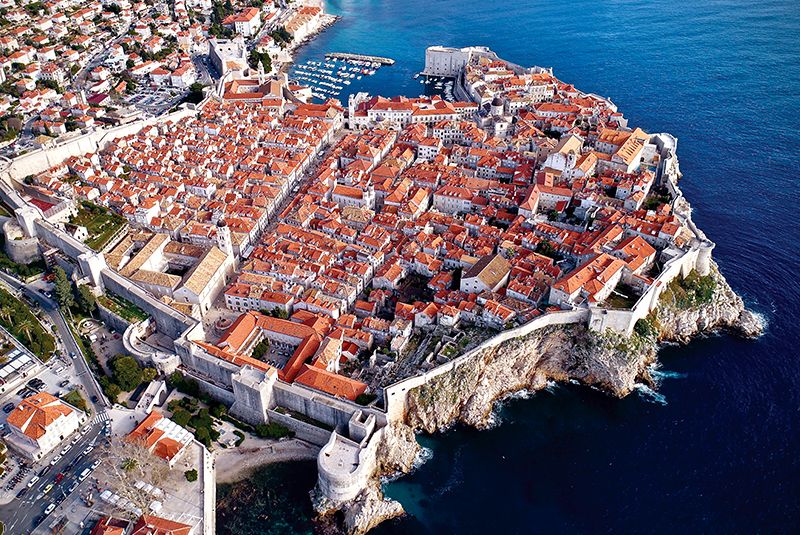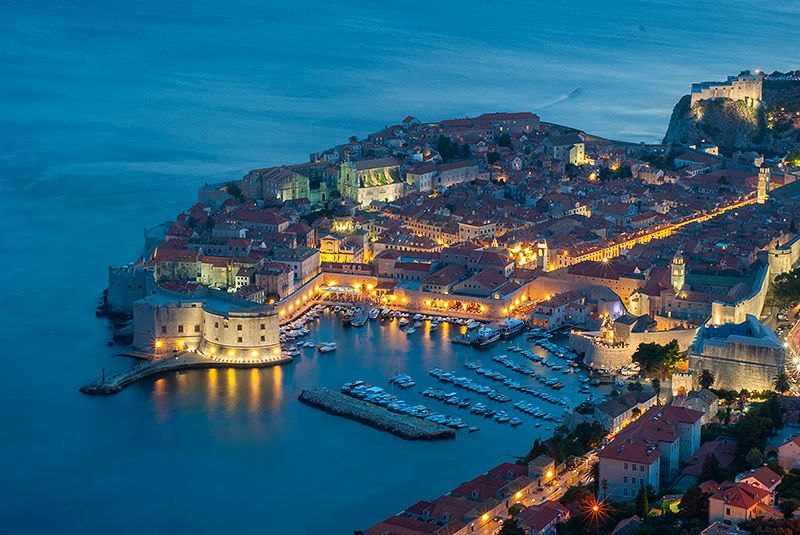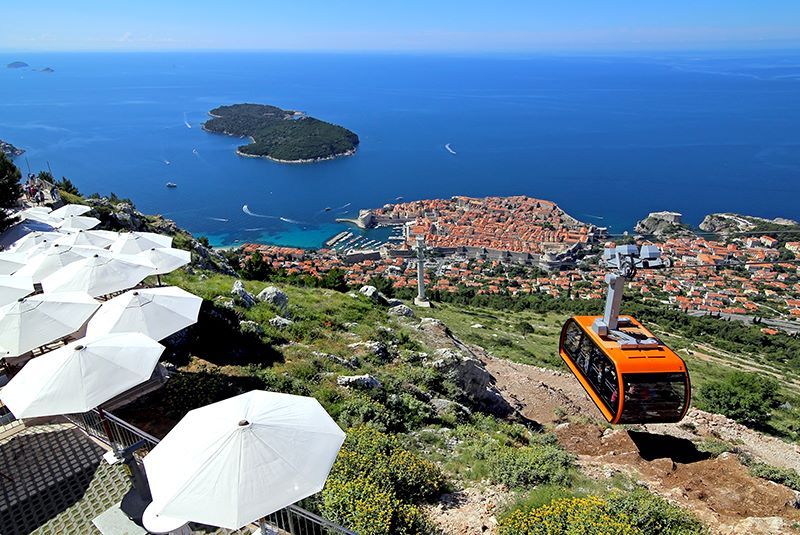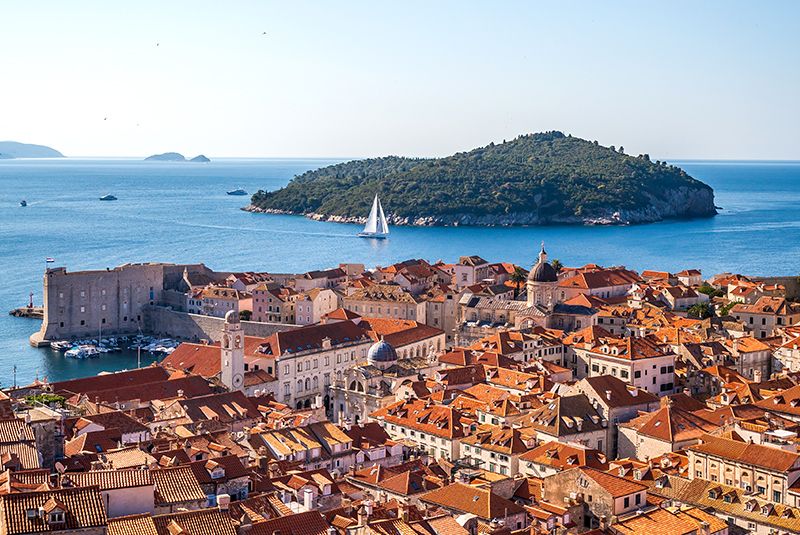When your business obligations or participation in a business, professional or social event bring you to Dubrovnik, you should definitely experience the city in its full glory and get to know its rich cultural and historical heritage. Meetings, conferences, presentations of new products, receptions and incentive programs organized in Dubrovnik usually include a tour of the city and its sights. But just in case, for your own list, we present you the top 5 attractions that you must not miss.
1. City walls and fortresses – centuries-old guardians of the city
To visit Dubrovnik and not climb its magnificent walls is simply unimaginable. They are one of the most monumental fortification systems in Europe – 1,940 metres long, and in some places up to 25 metres high. The construction of the first fortifications began back in the 8th century, their current extent dates back to the 13th century, and the most intensive construction was from the middle of the 15th to the end of the 16th century. With the founding of the Society of Friends of Dubrovnik Antiquities in 1952, systematic work began on the restoration and restoration of Dubrovnik’s city walls to their original state.
The city walls consist of the main city wall, sixteen towers, three fortresses, six bastions (strong pentagonal fortifications with sloping walls), two cantonates (corner fortifications), three pre-walls with a series of turrets (low semi-circular towers with sloping walls), three moats, two forts – fortresses and two city drawbridges and breakwaters. An integral part of the walls are fortresses that played an important role in the defence of the former Republic of Dubrovnik. On the highest part of the walls, the Minčeta fortress stands proudly – a symbol of Dubrovnik’s defence from the north. In the south-western part of the city, at the corner of the walls, stands the Bokar fortress, built in the 15th century to defend the western port of the city and the entrance to the city of Pile. Today it functions as a Lapidarian for numerous stone fragments from the Dubrovnik area. The interesting interior rooms of the Bokar fortress, such as the casemates for storing ammunition and smaller cannons and its terrace overlooking the sea, can be an interesting choice for organizing various events, such as banquets, presentations, etc. On the southeast side of the walls is the fortress of St. Ivan, built in 1346 to protect the city harbour from the southeast side. The Aquarium is located on the ground floor of the fortress, and the Maritime Museum is located on the first and second floors.
Two separate fortresses belong to this strong defence system – Lovrjenac in the west and Revelin in the east. Due to their imposing spaces and terraces, both are very frequent hosts of numerous cultural events. Lovrjenac fortress, located on a high cliff, is also a symbol of Dubrovnik’s freedom, a summer theatre stage for the Midsummer Scene Festival and the Dubrovnik Summer Festival, and Revelin is transformed into a concert hall for the performances of the Dubrovnik Symphony Orchestra and the Dubrovnik Summer Festival.
The city walls, this open-air museum made of centuries-old stone, is open to visitors throughout the year. You can enter the walls through one of three entrances – on Stradun near the gate from Pile and the church of St. Saviour, near the Maritime Museum – Fortress of St. Ivan and near the church of St. Luka in the east. A walk along the entire length of the walls, with breaks for photography and coffee, takes approximately 2 hours, and offers an irresistible view of Dubrovnik’s rooftops and the impressive sea.
2. Stradun and the old town centre – a walk through history

Due to its beauty and rich history, the entire old town of Dubrovnik was included in the list of UNESCO’s protected cultural heritage in 1979. Its central part is the city’s main street – Stradun or Placa, a favourite promenade and meeting place of Dubrovnik residents, the most beautiful city street and the historical shopping centre of the city. Take a walk along Stradun and explore the heart of Dubrovnik, get to know its alleys, squares, cathedrals, fountains, palaces and museums, and visit souvenir shops and goldsmiths who use old techniques to make traditional Dubrovnik jewellery.
At the western entrance to the city and Stradun, at the gate of Pile, where you can meet costumed city guards in the summer, is the Great Onofrio’s Fountain, named after the builder of the Dubrovnik waterworks from the 15th century. On the opposite, western side of Stradun, there is the famous Orlando’s column – a figure of a medieval knight with a sword, a symbol of statehood, on whose mast flew the national flag of the Republic of Dubrovnik, and today the flag of the Republic of Croatia. During the Festivities of St. Blaise, Dubrovnik’s patron saint, Orlando’s column is decorated with a banner with his image, and during the Dubrovnik Summer Festival, the Libertas banner. There is also the city bell tower with a clock, built in 1444 and 31 metres high, as well as one of the most beautiful palaces in the city – the Sponza Palace. Built in the 16th century, in the Gothic-Renaissance style, it has managed to preserve its original appearance to this day, and with its atrium and vaulted gallery, it is one of the most elegant event spaces in Dubrovnik.
Nearby is the church of St. Blaise, the patron saint of the city, built in the Gothic style according to the designs of the Venetian builder Marino Gropelli in 1715. In it, on the main altar, the Gothic statue of St. Blaise made of gilded silver from the 15th century. A place you should not miss is the Rector’s Palace, the palace that was the seat of the government and the Rector who was elected on a monthly basis. The courthouse, armoury and infamous dungeons were also located in the Palace, and today it is the Cultural and Historical Museum where you can find out everything about life from the time of the Republic of Dubrovnik, but also organize your event in an ambient environment.
It is definitely worth visiting the Dubrovnik Cathedral, a baroque church dedicated to the Assumption of the Blessed Virgin Mary. It was built on the site of a Byzantine and Romanesque cathedral that collapsed in the great earthquake of 1667, and its treasury houses numerous works of art, such as paintings by the famous Italian painters Raphael and Titian.
3. City harbour and Lazareti – a postcard from Dubrovnik

If you are sentimental and want to send a physical postcard from Dubrovnik, it will certainly have the most common motif and the most common photo of the city with a view of the city’s harbour, walls and Lazareti. Namely, if you continue the walk that started along Stradun, then past the Rector’s Palace and the cathedral to the east, you will reach the city port, which got its present form at the end of the 15th and the beginning of the 16th century. The Kaše breakwater protects the port and ships from big waves, but also from enemies, and later the pier with the Porporela lighthouse was built, today a promenade and a favourite place for lovers. The city harbour contained a large and small arsenal for the construction and repair of ships and boats, and today there are places to enjoy top Dubrovnik gastronomy – the restaurant Poklisar and the city café Arsenal Restaurant & Bar, which has an excellent offer for organizing formal dinners and similar events.
From the port, you can see the Lazareti – a striking building of the former quarantine centre. Infirmaries were built in the 17th century, and their importance in protecting Dubrovnik from infectious diseases, primarily the plague, was confirmed when in 1724 they were declared an integral part of the city’s protective fortifications. The Lazareti consists of a plateau and ten naves (halls), between which there are five inner courtyards. Like the rest of the city walls, Lazareti are very well preserved and are today one of Dubrovnik’s most spectacular event spaces, and some naves are home to art and craft workshops, the Linđo Folk Ensemble, the Association of Young Artists and others.
4. The Srđ mountain – cable car ride and panoramic view of Dubrovnik

In addition to the city walls, the perfect location for enjoying the wonderful view of Dubrovnik, the sea and the surrounding islands is certainly the Srđ hill, which rises as a natural protector of the city in the north. That is precisely why it was named after the oldest patron saint of Dubrovnik, St. Srđ. It is 413 metres high, and on it is the Imperial fortress, built during Napoleon’s occupation. Namely, it played an important defensive role in the Homeland War, which is why the fortress now houses the Museum of the Homeland War. There is also the Srđ Amphitheatre, which includes a restaurant, coffee bar and souvenir shop, and can be turned into an excellent open-air event space for up to 250 people.
From the top of Srđ, there is a wonderful view of Dubrovnik and the surrounding area, so you should not miss taking a photo to immortalize the breath-taking panorama. To make the experience even more interesting, be sure to choose the Srđ Cable Car as a means of transportation to the top, which will complete your experience. Having crossed a path of a total of 778 metres, two cabins with a capacity of 30 people will bring you to the top of Srđ in just four minutes. Just enough time to enjoy the moment and the view!
5. Lokrum Island and the Elaphite Islands – enjoy the boat ride and the irresistible nature

A sea adventure and a tour of the Dubrovnik archipelago is another activity that you should not miss during your stay in Dubrovnik. Only fifteen minutes by boat from the port of Dubrovnik is the islet of Lokrum, a favourite excursion and bathing spot of local residents and visitors. It was first mentioned in 1023 as the place of foundation of the Benedictine abbey and monastery. On Lokrum, Maximilian of Habsburg built a summer house on the ruins of the monastery and arranged a garden, paths and walkways. The tradition of arranging gardens and enriching natural vegetation with new, exotic species continued with the establishment of the Botanical Garden in 1959, and Lokrum was declared a nature reserve in 1963, then a Special Forest Vegetation Reserve in 1976. On the island there is also an unusual lake called Mrtvo More or the Dead Sea, connected to the open sea. On the hill of Lokrum is the star-shaped fortress Fort Royal, which was built by the French in 1806, and it offers a wonderful view of Dubrovnik, Cavtat and the islands.
Don’t miss a ride on the old Postira ferry to the Elaphite Islands – Koločep, Lopud and Šipan, which have been inhabited since ancient times. All three islands can be visited in one day, and each of them can be enjoyed in its own way. Visit the old Croatian churches on Koločep, swim on the sandy beach of Šunj in Lopud, and visit olive groves and vineyards in Šipan. Don’t miss the indigenous gastronomic offer, which includes freshly caught fish and organically grown vegetables, all seasoned with local olive oil and rounded off with a drop of local wine